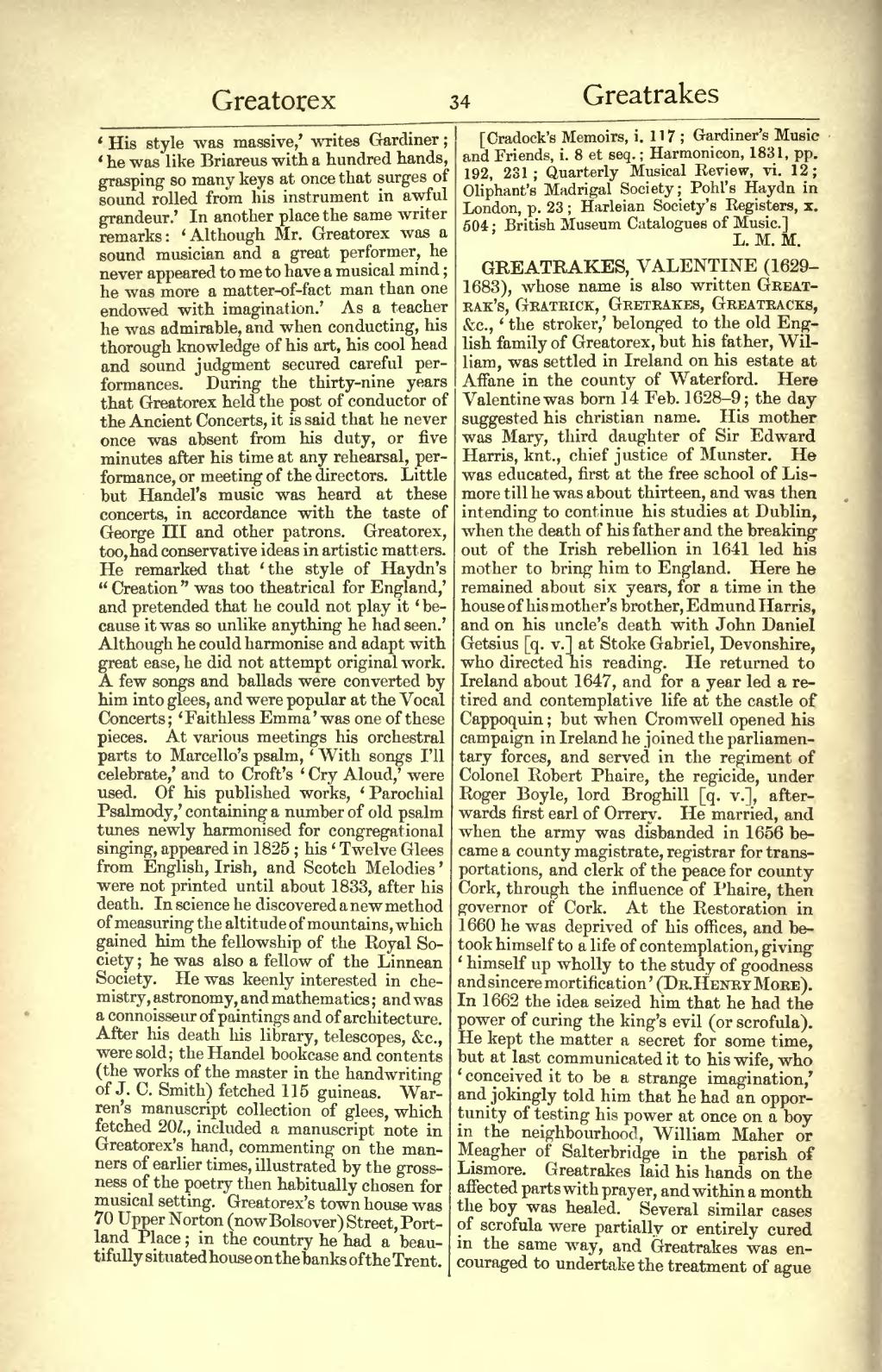‘His style was massive,’ writes Gardiner; ‘he was like Briareus with a hundred hands, grasping so many keys at once that surges of sound rolled from his instrument in awful grandeur.’ In another place the same writer remarks: ‘Although Mr. Greatorex was a sound musician and a great performer, he never appeared to me to have a musical mind; he was more a matter-of-fact man than one endowed with imagination.’ As a teacher he was admirable, and when conducting, his thorough knowledge of his art, his cool head and sound judgment secured careful performances. During the thirty-nine years that Greatorex held the post of conductor of the Ancient Concerts, it is said that he never once was absent from his duty, or five minutes after his time at any rehearsal, performance, or meeting of the directors. Little but Handel’s music was heard at these concerts, in accordance with the taste of George III and other patrons. Greatorex, too, had conservative ideas in artistic matters. He remarked that ‘the style of Haydn’s “Creation” was too theatrical for England,’ and pretended that he could not play it ‘because it was so unlike anything he had seen.’ Although he could harmonise and adapt with great ease, he did not attempt original work. A few songs and ballads were converted by him into glees, and were popular at the Vocal Concerts; ‘Faithless Emma’ was one of these pieces. At various meetings his orchestral parts to Marcello’s psalm, ‘With songs I’ll celebrate,’ and to Croft’s ‘Cry Aloud,’ were used. Of his published works, ‘Parochial Psalmody,’ containing a number of old psalm tunes newly harmonised for congregational singing, appeared in 1825; his ‘Twelve Glees from English, Irish, and Scotch Melodies’ were not printed until about 1833, after his death. In science he discovered a new method of measuring the altitude of mountains, which gained him the fellowship of the Royal Society; he was also a fellow of the Linnean Society. He was keenly interested in chemistry, astronomy, and mathematics; and was a connoisseur of paintings and of architecture. After his death his library, telescopes, &c., were sold; the Handel bookcase and contents (the works of the master in the handwriting of J. C. Smith) fetched 115 guineas. Warren’s manuscript collection of glees, which fetched 20l., included a manuscript note in Greatorex’s hand, commenting on the manners of earlier times, illustrated by the grossness of the poetry then habitually chosen for musical setting. Greatorex’s town house was 70 Upper Norton (now Bolsover) Street, Portland Place; in the country he had a beautifully situated house on the banks of the Trent.
[Cradock’s Memoirs, i. 117; Gardiner’s Music and Friends, i. 8 et seq.; Harmonicon, 1831, pp. 192, 231; Quarterly Musical Review, vi. 12; Oliphant’s Madrigal Society; Pohl’s Haydn in London, p. 23; Harleian Society’s Registers, x. 504; British Museum Catalogues of Music.]
GREATRAKES, VALENTINE (1629–1683), whose name is also written Greatrak’s, Gratrick, Gretrakes, Greatracks, &c., ‘the stroker,’ belonged to the old English family of Greatorex, but his father, William, was settled in Ireland on his estate at Affane in the county of Waterford. Here Valentine was born 14 Feb. 1628-9; the day suggested his Christian name. His mother was Mary, third daughter of Sir Edward Harris, knt., chief justice of Munster. He was educated, first at the free school of Lismore till he was about thirteen, and was then intending to continue his studies at Dublin, when the death of his father and the breaking out of the Irish rebellion in 1641 led his mother to bring him to England. Here he remained about six years, for a time in the house of his mother’s brother, Edmund Harris, and on his uncle’s death with John Daniel Getsius [q. v.] at Stoke Gabriel, Devonshire, who directed his reading. He returned to Ireland about 1647, and for a year led a retired and contemplative life at the castle of Cappoquin; but when Cromwell opened his campaign in Ireland he joined the parliamentary forces, and served in the regiment of Colonel Robert Phaire, the regicide, under Roger Boyle, lord Broghill [q. v.], afterwards first earl of Orrery. He married, and when the army was disbanded in 1656 became a county magistrate, registrar for transportations, and clerk of the peace for county Cork, through the influence of Phaire, then governor of Cork. At the Restoration in 1660 he was deprived of his offices, and betook himself to a life of contemplation, giving ‘himself up wholly to the study of goodness and sincere mortification’ (Dr.Henry More). In 1662 the idea seized him that he had the power of curing the king’s evil (or scrofula). He kept the matter a secret for some time, but at last communicated it to his wife, who ‘conceived it to be a strange imagination,’ and jokingly told him that he had an opportunity of testing his power at once on a boy in the neighbourhood, William Maher or Meagher of Salterbridge in the parish of Lismore. Greatrakes laid his hands on the affected parts with prayer, and within a month the boy was healed. Several similar cases of scrofula were partially or entirely cured in the same way, and Greatrakes was encouraged to undertake the treatment of ague
